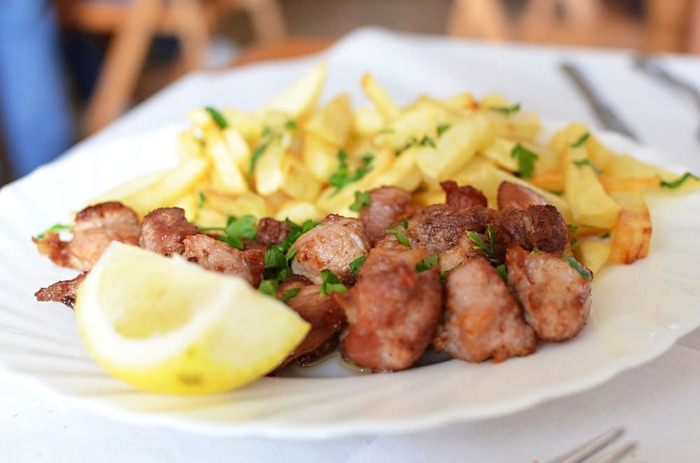What to eat
View Contents
ToggleWe are going to discuss the typical foods of the island of Tenerife. However, we cannot overlook the fact that these meals can also be found on other islands due to clear influences. We might more accurately speak of Canarian cuisine, although we make an effort to exclude those dishes that clearly represent other islands, focusing only on the food typical of Tenerife but not exclusively from Tenerife.
On the other hand, in this article we are not going to talk about good food, but about typical good food, which is not the same thing. For example, in Tenerife you can eat very good meat and ice cream, but they are not really typical food of Tenerife.
Guachinches
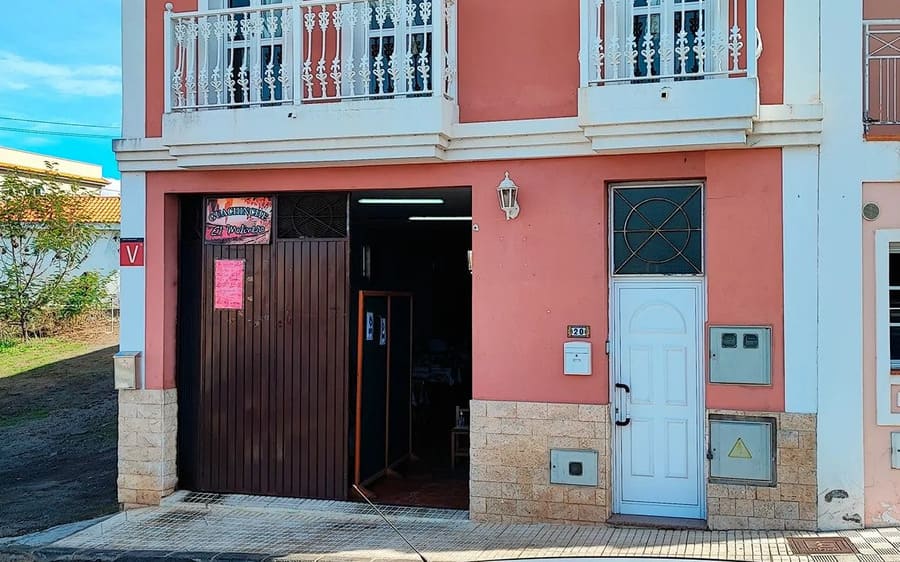
Although this article is aimed at the food itself and not the places to eat it, there is no doubt that we have to mention the guachinches.
The guachinches are places where you can eat typical food but their prices are also very cheap.
But we must be honest and warn that there are many places that call themselves guachinches, but they are just normal restaurants that pretend to be guachinches even though they are not.
Genuine guachinches are eating places that can only stay open for as long as the wine they grow lasts. So we have that guachinches:
- they are not open all year round
- they need to produce their own wine to sell
- they are usually located in the garage or lounges of the owners home
- they have very few dishes to serve
- are extremely homemade
Authentic guachinches are not so easy to find but if you can, don’t pass up the opportunity to go to one.
Papas arrugadas con mojo
«Papas arrugadas» are small potatoes boiled in very salty water until they wrinkle. They are usually served with mojo picón (a spicy sauce made from red or green peppers, garlic, cumin, and oil) and mojo verde (with cilantro or parsley). This dish is a must-have in any Canarian meal.
Cooking Method
The traditional method of cooking «papas arrugadas» is simple yet requires precision. The potatoes, preferably small and of a local variety, are washed but not peeled. They are placed in a pot, covered with water, and a generous amount of salt is added—up to a quarter of the weight of the potatoes in some cases. After boiling until the water evaporates, the potatoes are left in the pot, where the residual salt forms a crust on their skin as they finish cooking dry. The result is a tender potato inside with a wrinkled, salty skin that peels off easily.
Accompaniment: Canary Mojo
You can’t discuss «papas arrugadas» without mentioning Canary mojo, the sauces that traditionally accompany them. There are two main types: red, spicy mojo picón, and green mojo, made with cilantro or parsley. Both mojos are made with olive oil, vinegar, garlic, and spices, and provide a flavor counterpoint that perfectly complements the simplicity of the potatoes.
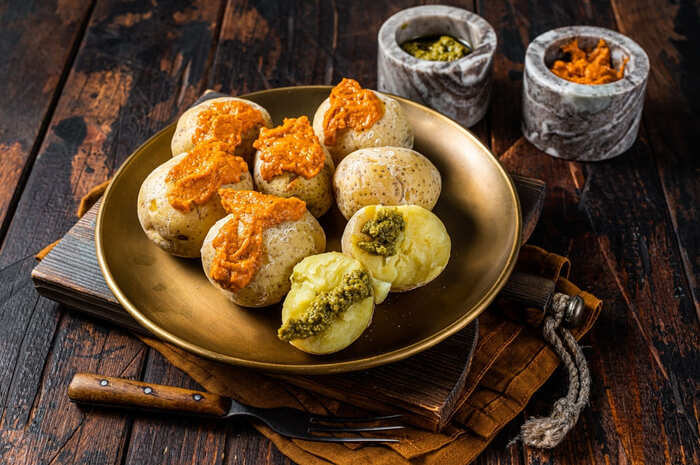
Gofio
Gofio is an unsifted flour made from millo (corn) or roasted wheat. It is an essential component of the Canarian diet, used in various forms: kneaded (mixed with broth, milk, or water and shaped into a ball), in stews, or even in desserts.
Production and Preparation
The preparation of gofio is relatively simple but requires a specific toasting process that is key to its characteristic flavor. The grains are carefully toasted before being ground into a fine powder. This process not only preserves the nutritional properties of the grains but also gives gofio its distinctive flavor and aroma.
In cooking, gofio is incredibly versatile. It can be consumed simply mixed with milk, as a substitute for bread, sprinkled over dishes such as soups and stews, or even used as a main ingredient in desserts. One of the most popular dishes using gofio is «escaldón,» a kind of thick mash that is typically served with fish or stews.
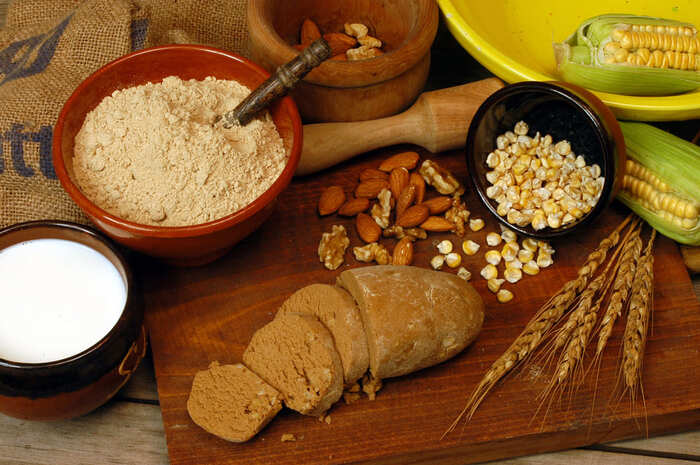
Conejo en salmorejo
This dish consists of rabbit marinated in a sauce called salmorejo (different from Andalusian gazpacho), made with garlic, paprika, cumin, vinegar, and other seasonings. Then, the rabbit is fried and served with the sauce.
Ingredients and Preparation
Rabbit in salmorejo sauce is prepared by first marinating the meat in a mixture that typically includes:
- Garlic: Chopped or crushed, it is essential for adding intense flavor.
- Paprika: Red, sweet or spicy, it adds color and depth to the dish.
- Vinegar and White Wine: These help to tenderize the meat and add acidity.
- Aromatic herbs: Such as thyme and bay leaf, which complement the meat with their aromas.
- Salt and pepper: For seasoning.
The meat is left to marinate for several hours, or even overnight, to allow the flavors to blend and penetrate well. After marinating, the rabbit is fried until golden and then simmered with its marinade and a bit of water or broth, until the meat is tender and the sauce has reduced, forming a delicious thick salmorejo.
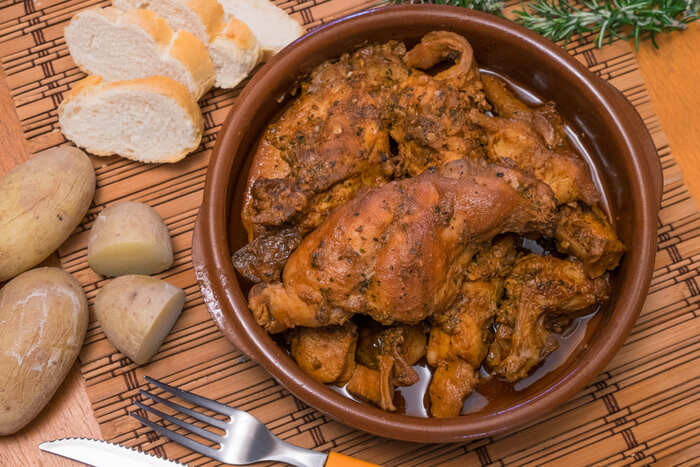
Ropa vieja
Originally a dish made with leftovers from the stew, Canarian ropa vieja includes chickpeas, shredded meat (usually chicken or beef), and sometimes potatoes, all sautéed with onion, garlic, and peppers.
Ingredients and Preparation
The base of Canarian «ropa vieja» includes shredded meat, which can be a combination of chicken, beef, and sometimes pork, depending on what is leftover from previous meals. Along with the meats, the dish includes chickpeas that are also repurposed from the stew. Additional ingredients include:
- Onion and garlic: Chopped and sautéed, they are essential for creating a flavor base.
- Red and green peppers: They add color and sweetness to the dish.
- Tomatoes: Fresh or pureed, they provide acidity and body to the sauce.
- Potatoes: They are often added to the stew, although some recipes serve them fried and separately.
- Spices: Paprika, cumin, and sometimes a touch of saffron or food coloring to give it a characteristic color and deeper flavor.
The cooking process begins with sautéing onion, garlic, and peppers in a bit of oil. Then the meats and chickpeas are added, followed by the tomatoes and spices. Everything is simmered until the flavors blend and the ingredients are tender. Finally, the potatoes are added, which can either be cooked within the stew or fried separately and served as a side.
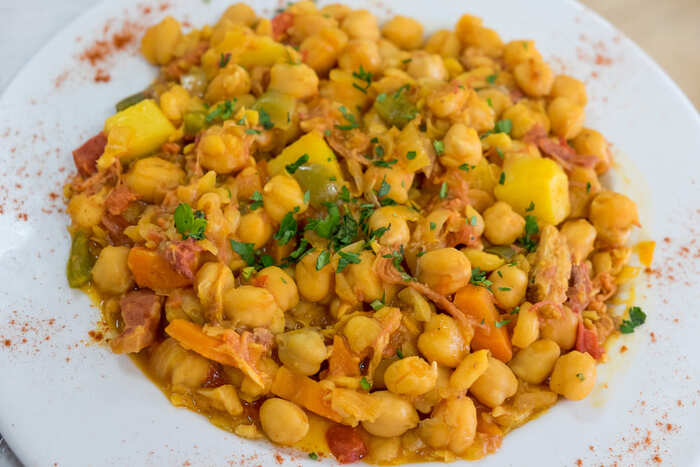
Potaje de berros
This is a thick, nutritious soup made with watercress, potatoes, pork ribs, piña de millo (corn), sweet potatoes, and gofio. It is especially popular in the colder months.
Ingredients and Preparation
The Canary Islands’ watercress stew includes a range of ingredients that contribute a rich complexity of flavors and textures. The main ingredients are:
- Watercress: Fresh and well-washed, it is the star ingredient of the dish.
- Potatoes: They add substance and help thicken the broth.
- Pumpkin: Its natural sweetness perfectly complements the slight spiciness of the watercress.
- Carrots and Peppers: They add color and nutritional richness to the stew.
- Onions and Garlic: Sautéed at the beginning, they are fundamental for any good stew.
- Pork ribs or chorizo: Optional, but common in many recipes, providing a smoky flavor and depth.
- Chickpeas: Often included after being soaked overnight and cooked in the stew, adding texture and protein.
The preparation begins by sautéing the onions and garlic in a little oil until they are translucent. Then the potatoes, pumpkin, carrots, and peppers are added, followed by the watercress and chickpeas. If meat, such as ribs or chorizo, is included, it would also be added at this point. The stew is covered with water and simmered until all the ingredients are tender and the flavors well integrated. The result is a thick, aromatic broth, with the vegetables and legumes perfectly cooked.
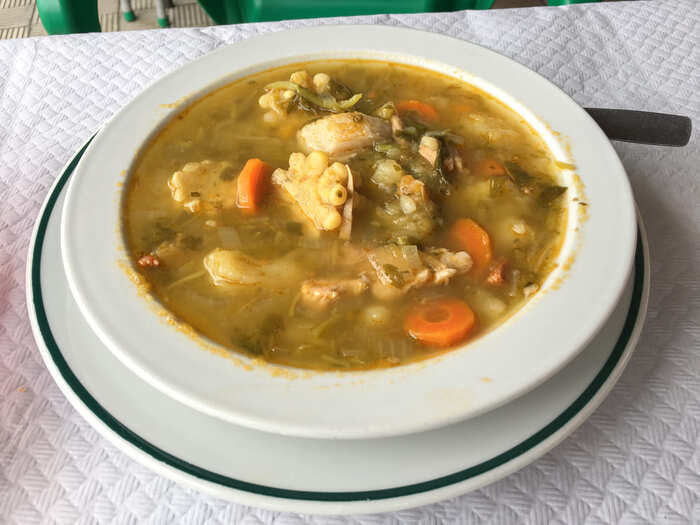
Rancho
Rancho Canario is a traditional dish from the Canary Islands, very popular in Tenerife. It is a thick and nutritious soup that combines simple local ingredients in a recipe rich in flavor and history. It is made with chickpeas, noodles, meat (beef or pork), vegetables (carrots, celery, onion), and spices.
Ingredients and Preparation
The basic ingredients of Canarian Stew include:
- Meats: Usually a combination of pork meats such as ribs or bacon, and chorizo, although some variations may include chicken or beef. The meats are cooked until tender, adding a rich flavor base to the dish.
- Chickpeas: Soaked overnight and added to the stew to provide texture and protein.
- Potatoes: Essential in almost all Canarian dishes, potatoes add substance and help thicken the broth.
- Noodles: Often, thick noodles or small pieces of pasta are incorporated to enrich the stew.
- Vegetables: Onions, garlic, peppers, and tomatoes are sautéed at the beginning to create an aromatic base. Other vegetables like carrots and cabbage may be added to increase nutritional value and flavor complexity.
- Spices and herbs: Paprika, bay leaf, and thyme are typical, providing depth and a characteristic aroma.
The cooking process begins with the sautéing of the vegetables, to which the meats are added to brown slightly. Chickpeas and enough water to cover all the ingredients are then incorporated. The stew is simmered, allowing the flavors to meld. Toward the end of cooking, the noodles are added, and the seasoning is adjusted.
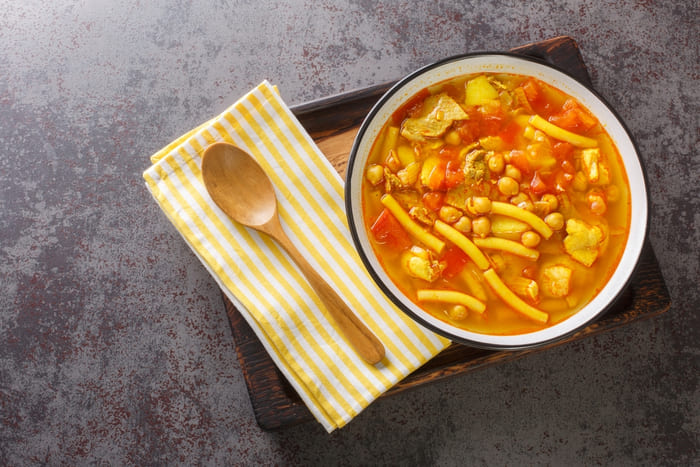
Puchero (sancocho)
This dish is typically served during Holy Week. It’s a simple but tasty stew of salted fish (usually cherne), accompanied by potatoes, sweet potatoes, and mojo verde.
Ingredients and Preparation
The typical ingredients of the Canarian stew include:
- Meats: Various types are used, including chicken, pork, and sometimes beef or lamb. Salted ribs and chorizo are also popular additions that provide an intense flavor to the broth.
- Legumes: Chickpeas are an essential ingredient in the Canarian stew, adding texture and protein richness to the dish.
- Vegetables: The stew includes a generous variety of vegetables such as potatoes, carrots, squash, corn on the cob, and cabbage. Other local vegetables like bubango (a type of zucchini) or yam may be included depending on the season and availability.
- Herbs and spices: Herbs such as cilantro or parsley and spices like paprika are used to give the stew its characteristic aroma and flavo
- Cook the Meats: Start by cooking the tougher meats like beef or pork, and then add the softer ones like chicken. Salted meats should be desalted before cooking by soaking them in water overnight.
- Add Legumes and Vegetables: Chickpeas usually need to be soaked in advance. Add vegetables based on their cooking times, starting with those that take longer to cook like potatoes and carrots.
- Simmering: Let the entire stew simmer slowly until all the ingredients are tender and the flavors have melded.
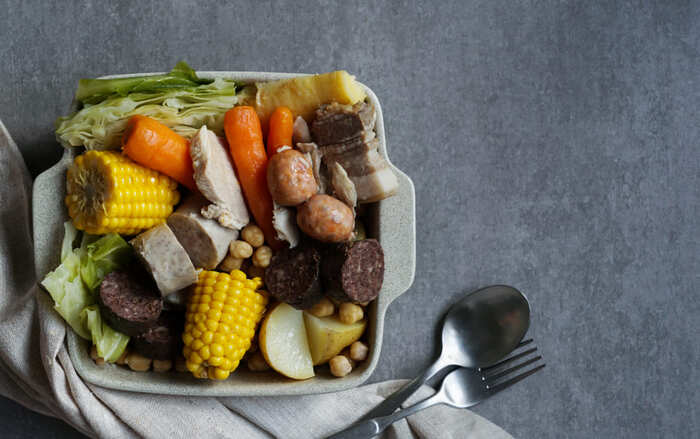
Queso asado con mojo
Grilled cheese is a popular starter in Tenerife. It consists of Canarian cheese (usually goat) grilled or pan-fried and served with mojo picón.
Ingredients and Preparation
Canarian Cheese: This dish commonly uses tender or semi-cured cheese, such as Canarian goat cheese. This type of cheese has the firmness needed to be grilled without melting away and possesses a mild flavor that perfectly complements mojo sauces.
Red or Green Mojo: These are the two most common variants of mojo. Red mojo is an emulsion of olive oil, garlic, paprika, cumin, and vinegar, while green mojo includes cilantro or parsley in addition to the other ingredients
Cutting the Cheese: The cheese is cut into thick slices or a large block that can maintain its shape when cooked.
Grilling the Cheese: The cheese is grilled in a pan over medium-high heat or under the oven grill until the surface is golden and begins to bubble. It’s important to watch it carefully to ensure it browns without burning.
Preparing the Mojo: While the cheese is grilling, prepare the mojo by grinding garlic with salt, cumin, and peppers (for red mojo) or cilantro/parsley (for green mojo) in a mortar. Then, emulsify it with olive oil and a bit of vinegar to achieve the desired consistency.
Serving: The hot cheese is immediately served, generously topped with either red or green mojo.

Escaldón
Escaldón is a type of mush made with gofio and fish or meat broth. It is often eaten as a side or as a main dish itself and can include pieces of meat or fish.
Ingredients and Preparation
Gofio: Traditionally, gofio is made from wheat or corn, but it can also be made from other grains. The gofio used in escaldón is usually from millo (corn) or wheat, or a mixture of both.
Broth: Escaldón is prepared by mixing gofio with a broth, which can be fish, chicken, meat, or even a vegetable broth. The choice of broth varies according to personal preferences and the type of dish with which it will be served.
The broth should be well-seasoned and hot. It can be leftover from another stew or prepared specifically for this dish. Mixing with Gofio: In a large bowl, pour the gofio and gradually add the broth, stirring constantly to avoid lumps. The desired consistency is similar to that of a thick porridge, although this can vary according to taste. Serving: The escaldón is served hot and is often accompanied by chopped onion, sprinkled cilantro or parsley, or even with pieces of fish or shredded meat.
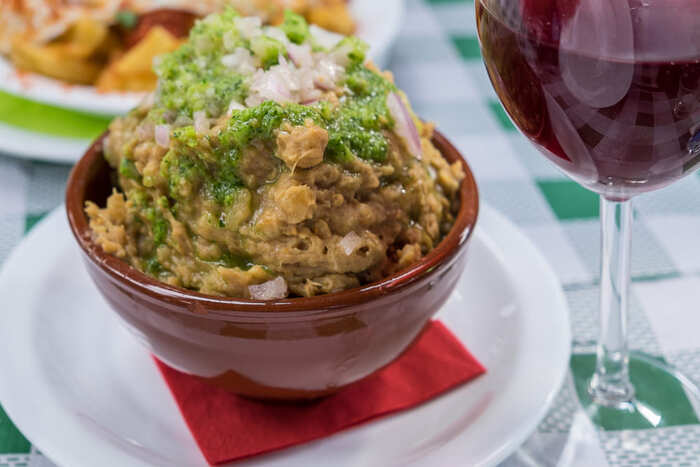
Frangollo
This is a typical dessert in Canarian cuisine. Frangollo is made with milk, ground corn (milhojas), sugar, lemon, almonds, raisins, and cinnamon. It’s a sweet dish served cold and is especially popular during local festivals and family celebrations.
Ingredients and Preparation
Cornmeal: The base of frangollo is cornmeal, which is usually ground coarser than conventional corn flour.
Milk: Cow’s milk or a mix of milk and a little water can be used to cook frangollo.
Sugar: To sweeten the dessert.
Butter or lard: Added to enrich the texture and give a subtle creamy flavor.
Eggs: Help bind all the ingredients and add smoothness to the dessert.
Lemon and orange: The zest of these fruits is used to flavor the frangollo, providing a citrus touch that balances the sweetness.
Cinnamon and vanilla: To season and add layers of flavor.
Raisins and almonds: Optional, but commonly included to add texture and a rich flavor to the dish.
Mix dry ingredients: In a large bowl, mix the cornmeal with sugar and cinnamon. Add liquids and cook: In a pot, heat the milk with butter, vanilla, and lemon and orange zests until almost boiling. Then, pour this liquid mixture over the dry ingredients, stirring constantly to avoid lumps. Add eggs and nuts: Beaten eggs are incorporated and, if desired, raisins and almonds. The mixture is returned to the pot and cooked over low heat, stirring frequently, until it thickens and the flavors have integrated. Cool and serve: Frangollo is allowed to cool to room temperature and then refrigerated. It is served cold, sprinkled with additional cinnamon or decorated with more almonds and raisins.
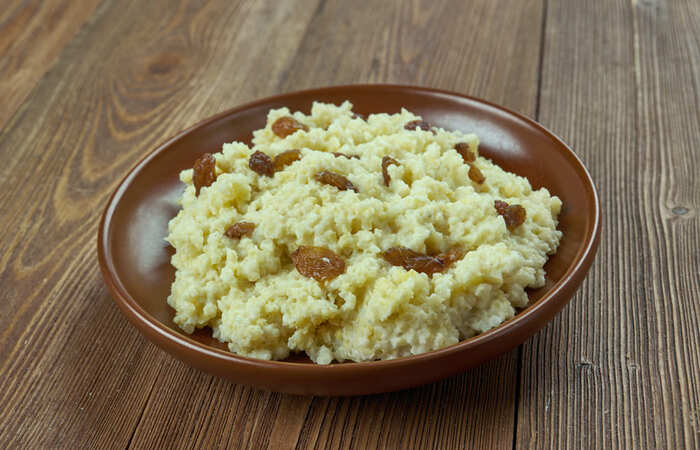
Tollos
Tollos are strips of dehydrated dogfish, which are rehydrated and cooked in a spicy tomato sauce with garlic, cumin, and paprika. This dish is another example of how Canarian cuisine uses traditional preservation techniques to create flavorful dishes.
Ingredients and Preparation
Tollos: Small sharks, traditionally dogfish, dried and salted.
Tomato Sauce: Base for the sauce in which the tollos will be cooked.
Garlic, Paprika, and Chili Pepper: To flavor and add a spicy touch to the dish.
Olive Oil: Used to sauté the aromatics and create a rich base for the sauce.
Vinegar and White Wine: Add acidity and depth to the stew.
Bay Leaf: An herb that provides a subtle but distinctive aroma.
Desalt the Tollos: First, it is necessary to desalt the tollos by soaking them in water for several hours, changing the water several times.Prepare the Sauce: In a pan, sauté the garlic and chili peppers in olive oil. Then add the paprika, tomato sauce, bay leaf, vinegar, and white wine, letting everything simmer.Cook the Tollos: The tollos are added to the sauce and cooked until they are tender and fully imbued with flavor. This process can take some time, depending on the desired texture.
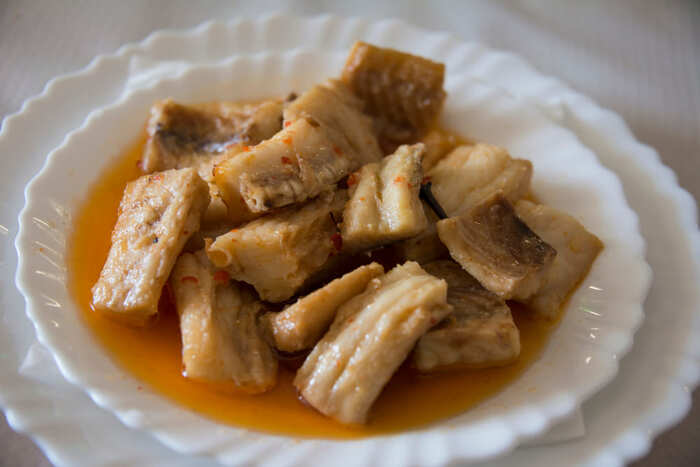
Carne fiesta
«Carne Fiesta» is a popular dish during festivities in Tenerife. It consists of pork pieces marinated in a spicy adobo made with garlic, paprika, oregano, cumin, salt, vinegar, and white wine. The meat is then fried until crispy and is typically served as an appetizer or tapa.
Ingredients and Preparation
Pork Meat: Typically uses loin or tenderloin, cut into cubes or strips.
Marinade: The marinade is key to the distinctive flavor of the carne fiesta. It includes garlic, paprika (sweet and/or spicy), thyme, oregano, salt, pepper, and sometimes a bit of cumin.
White Wine: Essential for marinating the meat, helping to tenderize it and add depth of flavor.
Vinegar: Provides a touch of acidity to the marinade.
Chili Pepper: For those who prefer a spicy touch, chili peppers can be added to taste.
Olive Oil: For frying the meat.
Marinate the Meat: The pork is marinated in a mixture of crushed garlic, paprika, thyme, oregano, salt, pepper, white wine, vinegar, and chili peppers if desired. This process is crucial and it is recommended to marinate for at least 24 hours to allow the flavors to fully infuse. Fry: Once marinated, the meat is fried in hot olive oil until it is well browned and crispy on the outside, but juicy on the inside. Serve: The carne fiesta is generally served hot, often accompanied by papas arrugadas and mojo picón, or simply with some fresh bread to enjoy the juices.
